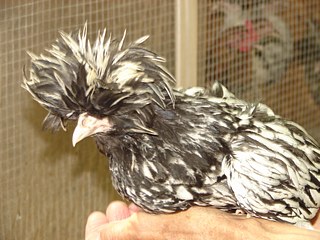Poultry Breeds: A Brief History of the Origin of the Chicken
Where did our poultry breeds that we love and take care of today originally come from? How did the development of the chicken breeds we know today come about? These are questions that you may be asking yourself as you get more and more into raising backyard chickens.
Scientifically you have three parts when it comes to tracing this. You have a species, breed, and then varieties.
A species is a group of organisms that are genetically similar. This means that they can often interbreed and exchange offspring that are similar enough to create a different breed. Mixed in these breeds you will then have different varieties which means they are genetically very similar, but may vary in color and other small characteristics.
So, when looking at poultry breeds it is easy to tell that chickens
are of the same species, but it is also easy to tell an Ameraucana from a
Leghorn and a Jersey Giant from a Spangled Hamburg Bantam, so breed
characteristics are pretty easy to see as well. You will also see the
variety from a Buff Orpington and a Black Orpington, as the colors are
quite different.
As humans came into the picture, they began purposefully breeding chickens to create characteristics that they found favorable. They bred these birds to produce eggs they wanted, to produce bodies that were fit for eating, and even for their appearance.
The APA (American Poultry Association) was founded in 1873 and became the creators of what they term the standard of perfection for different breeds. They determine what makes a good bird for each breed and if they are willing to even create a new breed. The ABA (American Bantam Association) does the same thing for the Bantam breeds.
This gives you is lots of choices when it comes to what you would like to have in your backyard flock. Whether you want to raise chickens that are of the same breed and keep them at a certain standard or if you want to have lots of variety in your flock with many different breeds present you can do either.

Choosing the right breed does not have to be a huge undertaking. Do you want eggs? If so, research some of the breeds below to see what breeds produce the varieties of eggs that you like to eat. Are you raising chickens for meat?
If you are, you can research below and find out what poultry breeds are best for eating. Do you want a combination of a good egg layer as well as a meat bird? Yes, there are breeds just for that.
Basically it is a personal choice and it doesn't have to be complicated. It can be as simple as your son our daughter fell in love with one particular chick at the hatchery and that is the one you picked.
Check back as we will continue to update the list of poultry breeds below!!
Poultry Breeds:
Ameraucana: the American made Easter egg bird.
American Game Bantam: a showy breed that is hardy and vigorous.
Ancona: a good layer of large white eggs.
Andalusian: the andalusian is a good egg layer with an almost ornamental look.
Appenzeller: the funky looking Swiss breed.
Araucana: the Chilean breed that lays the multi-colored egg.
Aseel:
an ancient game breed that may be the most aggressive breed.
Australian Game the Australian breed derived from the Australian Pit Game.
Australian Langshan: the number one breed down under.
Australian Pit Game Fowl: The fighting Aussie breed.
Australorps: the breed from Australia.
Barbu de Watermael: the Belgian bearded bantam.
Barnevelder: this bird lays a dark brown egg with a coppery tinge.
Barred Plymouth Rock: The Plymouth Rock breed is beautiful and a great dual purpose bird.
Bearded D'Anvers Bantam: the truly Bantam bird from Belgium.
Bearded d'Uccle: this Bantam is from Belgium and is a good layer of small eggs.
Belgian d'Everberg: the Belgian Bantam from Everberg.
Black Shumen: the old crossed Bulgarian breed.
Blue Hen of Delaware: this chicken is the state bird of Delaware and the mascot for the University of Delaware.
Booted Bantam: the well feathered Dutch breed.
Braekel: the old European breed.
Brahma: this breed is hardy, large, and a good winter layer.
Buckeye: the Ohio breed that is a good meat bird.
Buff Orpington: the great diverse use chicken breed.
California White: the great egg laying hybrid from California.
Campine: the Belgium breed that is a great layer of a medium-size egg.
Catalana: this breed is the only one in the Mediterranean class that was bred to have dual purpose qualities.
Chantecler: the Canadian original that is a good winter layer.
Cochin: the docile and friendly breed.
Cornish: this breed is the cornerstone of the commercial broiler industry.
Crevecoeur: the ornamental French breed.
Cubalaya: the Cuban game breed.
Delaware: an excellent broiler bird that was developed from crossing Barred Plymouth Rocks and New Hampshire's.
Dominique: this barred colored breed is the oldest American.
Dorking: a good dual purpose bird with fine textured meat.
Dutch Bantam: a true Bantam that is a good layer of small eggs.
Faverolle: the French bird with the good temperament.
Fayoumi: the ancient Egyptian breed.
Hamburg: the hamburg is an excellent layer of small white eggs.
Holland: this breed is a nice dual purpose layer of white eggs.
Houdan: the French breed that is a decent dual purpose bird.
Iowa Blue: the rare dual purpose breed from Iowa that really isn't that blue.
Poultry Breeds Continued (J-Z) Return from Poultry Breeds to Raising Chickens Homepage

New! Comments
Have your say about what you just read! Leave me a comment in the box below.